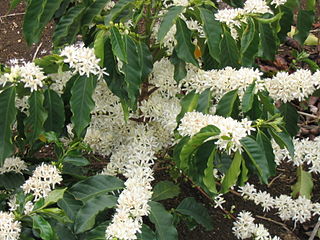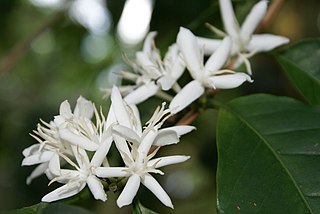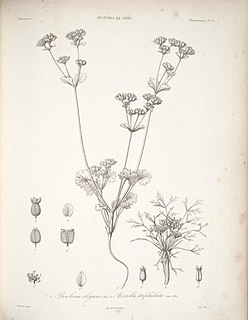
Coffea is a genus of flowering plants in the family Rubiaceae. Coffea species are shrubs or small trees native to tropical and southern Africa and tropical Asia. The seeds of some species, called coffee beans, are used to flavor various beverages and products. The fruits, like the seeds, contain a large amount of caffeine, and have a distinct sweet taste and are often juiced. The plant ranks as one of the world's most valuable and widely traded commodity crops and is an important export product of several countries, including those in Central and South America, the Caribbean and Africa.

Discaria is a genus of 6 species of flowering plants in the family Rhamnaceae, native to temperate regions of the Southern Hemisphere, in Australia, New Zealand and South America.

Selenicereus, sometimes known as moonlight cactus, is a genus of epiphytic, lithophytic, and terrestrial cacti, found in Mexico, Central America, the Caribbean and northern South America. The term night-blooming cereus is also sometimes used, but this is also used for many night-blooming cacti, including Epiphyllum and Peniocereus. In 2017, the genus Hylocereus was brought into synonymy with Selenicereus. A number of species of Selenicereus produce fruit that is eaten. The fruit, known as pitaya or pitahaya in Spanish or as dragon fruit, may be collected from the wild or the plants may be cultivated.

Colletia is a genus of flowering plants in the family Rhamnaceae, with 5 species of spiny shrubs. All species of this genus are native to southern South America. They are non-legume nitrogen fixers.

Phuopsis stylosa, the Caucasian crosswort or large-styled crosswort, is a low-growing, mat-forming, aromatic perennial plant in the madder, or bedstraw family Rubiaceae. It has whorls of narrow, aromatic leaves and terminal clusters of tubular pink flowers. Phuopsis stylosa is native to the Caucasus and Iran, and is widely grown elsewhere as a garden plant.

Hopea is a genus of plants in the family Dipterocarpaceae. The genus was named after John Hope, 1725–1786, the first Regius Keeper of the Royal Botanic Garden, Edinburgh. It contains some 113 species, distributed from Sri Lanka and southern India to southern China, and southward throughout Malesia to New Guinea. They are mainly main and subcanopy trees of lowland rainforest, but some species can become also emergent trees, such as Hopea nutans.

Kraussia is a flowering plant genus in the family Rubiaceae. Apart from a species in Socotra, they are native to continental Africa. The type was described from a plant collected by Dr. F. Krauss near Durban. It is differentiated from Tricalysia and Empogona by the ovule arrangement inside the ovary cells. The genus contains between 4 and 10 species, including:

Psydrax is a genus of flowering plants in the family Rubiaceae. It consists of trees, shrubs, and a few lianas in the paleotropics.
Remijia is a genus of flowering plants in the family Rubiaceae. Within the family, it is a member of the subfamily Cinchonoideae and the tribe Cinchoneae.

Lumnitzera is an Indo-West Pacific mangrove genus in the family Combretaceae. An English common name is black mangrove. Lumnitzera, named after the German botanist, Stephan Lumnitzer (1750-1806), occurs in mangroves from East Africa to the Western Pacific, and northern Australia.

Neonauclea is a genus of flowering plants in the family Rubiaceae. It comprises about 71 species. Neonauclea is a genus of shrubs and trees They are indigenous to China, India, Southeast Asia, Wallacea, New Guinea and Australia.
Argostemmateae is a tribe of flowering plants in the family Rubiaceae and contains about 215 species in 4 genera. Its representatives are found in tropical Africa, and tropical and subtropical Asia.

Coffeeae is a tribe of flowering plants in the family Rubiaceae and contains about 303 species in 11 genera. Its representatives are found in tropical and southern Africa, Madagascar, the western Indian Ocean, tropical and subtropical Asia, and Queensland.

Neurocalyx is a plant genus in the coffee family Rubiaceae. Species are found in southern India and Sri Lanka.

Holigarna is a genus of trees in the subfamily Anacardioideae of the cashew and sumac family Anacardiaceae. They grow naturally in India, Bangladesh and Indo-China. This is a poisonous tree if contacted it would irritate skin chemically and result in irreversible skin damage. Smoke from burning this wood is dangerously disabling.
Alexander Carroll Maingay was a British physician, botanist and botanical collector.

Mickelopteris is a genus of ferns in the subfamily Cheilanthoideae of the family Pteridaceae with a single species Mickelopteris cordata. Synonyms include Parahemionitis cordata and Hemionitis cordataRoxb. ex Hook. & Grev. The species is native to south-eastern Asia, from India to Taiwan and the Philippines.

Homalocarpus is a genus of flowering plants in the family Apiaceae, found in Chile. They are annual herbs with white, yellow, red or purple flowers.
Sphinctanthus is a genus of flowering plants in the family Rubiaceae, native to tropical South America. It is in a clade with Rosenbergiodendron and Tocoyena.
Synaptantha is a genus of flowering plants belonging to the family Rubiaceae.















